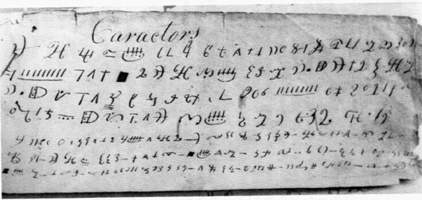
FAIR is a non-profit organization dedicated to providing well-documented answers to criticisms of the doctrine, practice, and history of The Church of Jesus Christ of Latter-day Saints.
(→{{Question label}}: mod) |
|||
| Line 58: | Line 58: | ||
#{{note|rsr2}} {{RSR|start=65|end=66}} | #{{note|rsr2}} {{RSR|start=65|end=66}} | ||
#{{note|newlight1}} {{JBMS-8-1-13}} ; citing David H. Kelley, “Cylinder Seal from Tlatilco,” ''American Antiquity'' 31 (July 1966): 744–746 and John A. Graham’s comments on Hanns J. Premm, “Calendrics and Writing,” in ''Observations on the Emergence of Civilization in Mesoamerica'', ed. Robert F. Heizer and John A. Graham (Berkeley: University of California Archaeological Research Facility, 1971), 133. | #{{note|newlight1}} {{JBMS-8-1-13}} ; citing David H. Kelley, “Cylinder Seal from Tlatilco,” ''American Antiquity'' 31 (July 1966): 744–746 and John A. Graham’s comments on Hanns J. Premm, “Calendrics and Writing,” in ''Observations on the Emergence of Civilization in Mesoamerica'', ed. Robert F. Heizer and John A. Graham (Berkeley: University of California Archaeological Research Facility, 1971), 133. | ||
#{{note|godfrey1}} ''Millennial Star'' 44:87; quotation from {{Ensign1|author=Kenneth W. Godfrey|article=A New Prophet and a New Scripture: The Coming Forth of the Book of Mormon|date=January 1988|start=6}}{{link|url=http://library.lds.org/nxt/gateway.dll/Magazines/Ensign/1988.htm/ensign%20january%201988.htm/a%20new%20prophet%20and%20a%20new%20scripture%20the%20coming%20forth%20of%20the%20book%20of%20mormon.htm?fn=document-frame.htm$f=templates$3.0}} | |||
# {{note|victims1}} Richard E. Turley, Jr., ''Victims: The LDS Church and the Mark Hofmann Case'' (Urbana and Chicago: University of Illinois Press, 1992), 24–39. | # {{note|victims1}} Richard E. Turley, Jr., ''Victims: The LDS Church and the Mark Hofmann Case'' (Urbana and Chicago: University of Illinois Press, 1992), 24–39. | ||
{{FurtherReading}} | {{FurtherReading}} | ||
This page is based on an answer to a question submitted to the FAIR web site, or a frequently asked question.
==== What do we know about the Anthon transcript and the translation of the Book of Mormon? What is the current scholarly thought on the transcript? Didn't Charles Anthon deny having "validating" the characters?
To see citations to the critical sources for these claims, click here
==== If Charles Anthon really did tell Martin that the characters and translation were bogus, it would therefore be very strange for Martin Harris to immediately return home, help Joseph translate the Book of Mormon, provide funds, and eventually mortgage his farm to help print it.
On the other hand, Anthon clearly had no desire to have his name associated with "Mormonism," and so he has clear motives to alter the story after the fact.[1]

More than one copy of the "Anthon transcript" exists. The oldest known copy (pictured here) is in the possession of the Community of Christ (formerly the Reorganized Church of Jesus Christ of Latter Day Saints). The paper seems to be of the same age and type as that used by Joseph Smith for the Book of Mormon translation.[2]
Joseph describes how between December 1827 and February 1828,
Joseph then described how Martin Harris carried the transcripts to experts in the east.
Martin Harris' account of the visit to Charles Anthon was included in Joseph Smith's 1838 history:
Anthon denied that he had ever validated either the characters or Joseph's translation, though his two written accounts contradict each other on key points.[4] For example:
A clue as to what Anthon said may be found in Martin Harris' reaction. Martin was a shrewd farmer and businessman, and a man of some property. He often warred between belief and doubt. For example, Martin put Joseph to the test during the translation of the 116 pages with the seer stone:
Mark Hofmann also forged a document based on the Anthon transcript, which he presented to the Church on 22 April 1980. Prior to the forgery being revealed, it was thought that this was the earliest extant Joseph Smith holograph.[6]
Characters in the authentic Anthon transcript(s) have been reported on two "Mexican seals made of baked clay" dating from no later than 400 B.C. Non-LDS archaeologists have remarked on this "hitherto unknown writing system" which "closely resemble various oriental scripts ranging from Burma and China to the rim of the Mediterranean," which if authentic "would almost surely be...an instance of transpacific contact during the Preclassic [pre-A.D. 400]." Other examples of the same script may also have been found between 1921 and 1932.[7] This is currently an area requiring more research.
A good summary of current scholarly opinion on the Anthon transcript can be found in:
== Notes ==

FAIR is a non-profit organization dedicated to providing well-documented answers to criticisms of the doctrine, practice, and history of The Church of Jesus Christ of Latter-day Saints.
We are a volunteer organization. We invite you to give back.
Donate Now